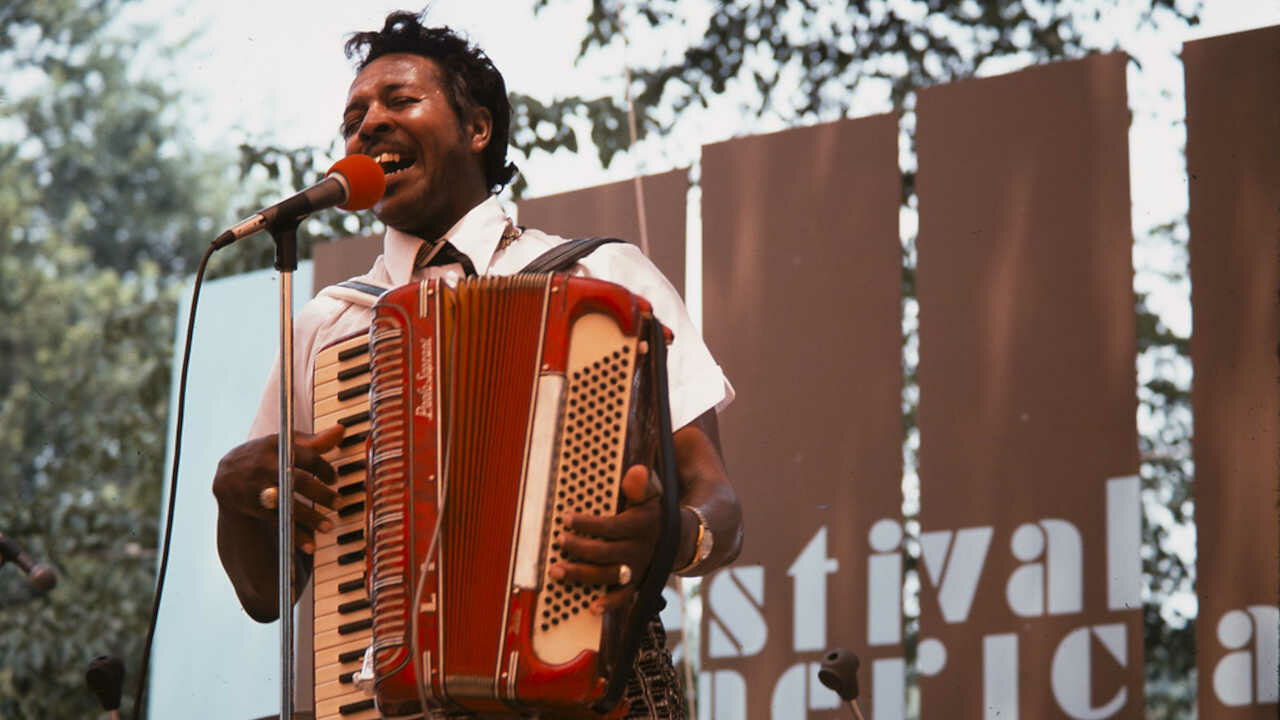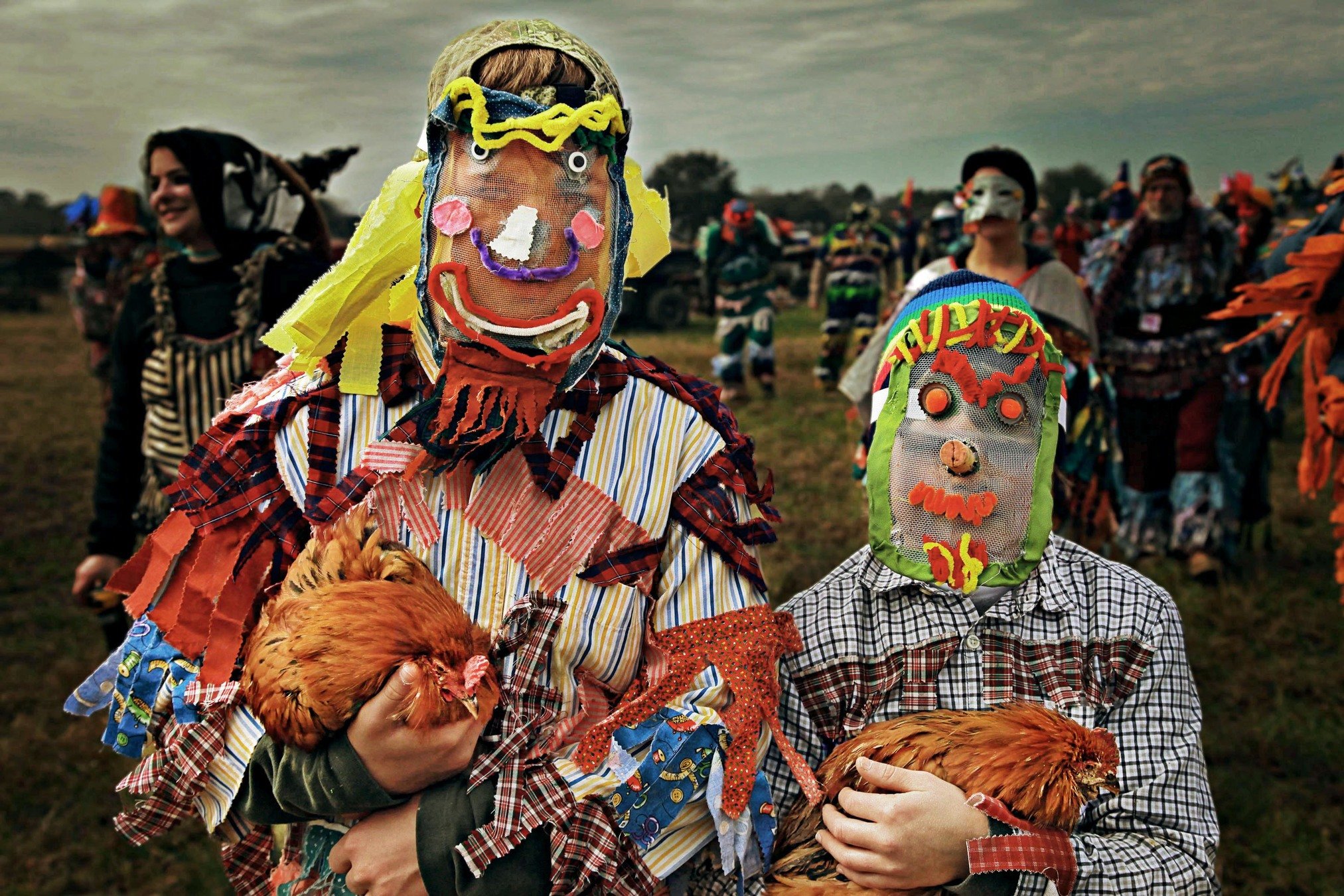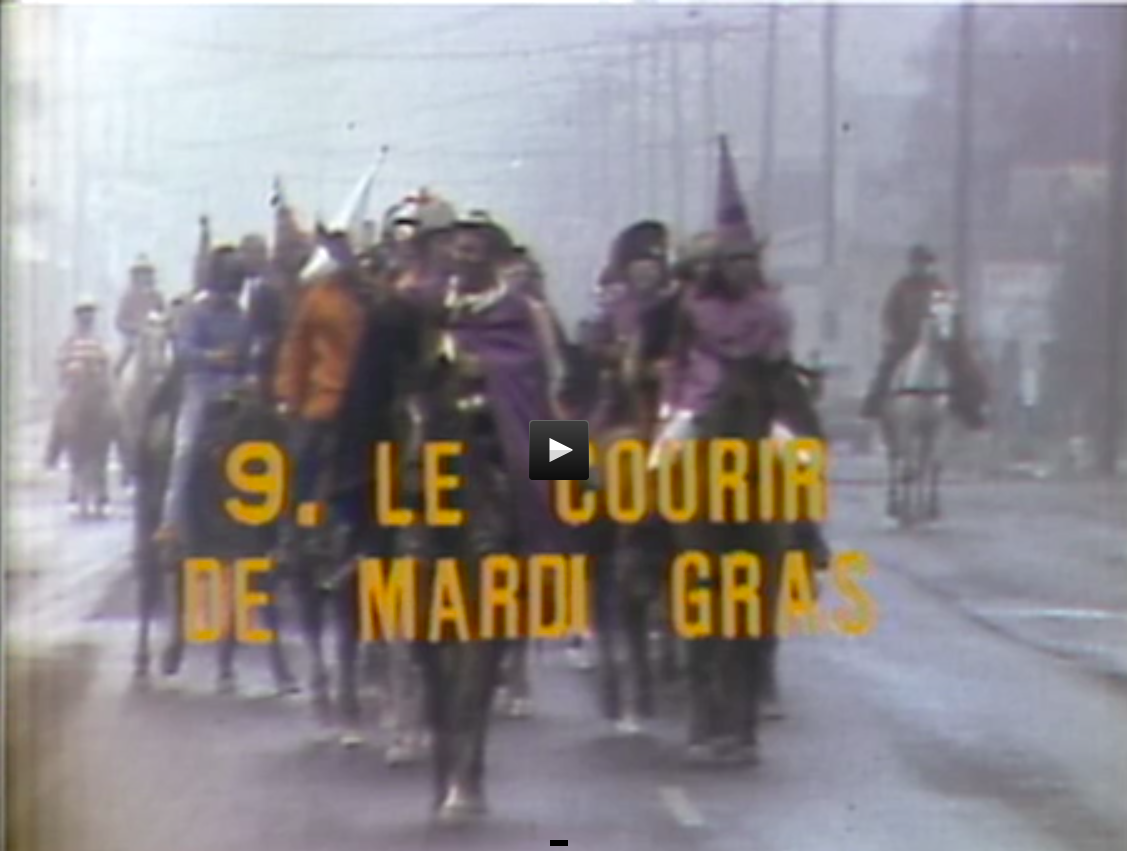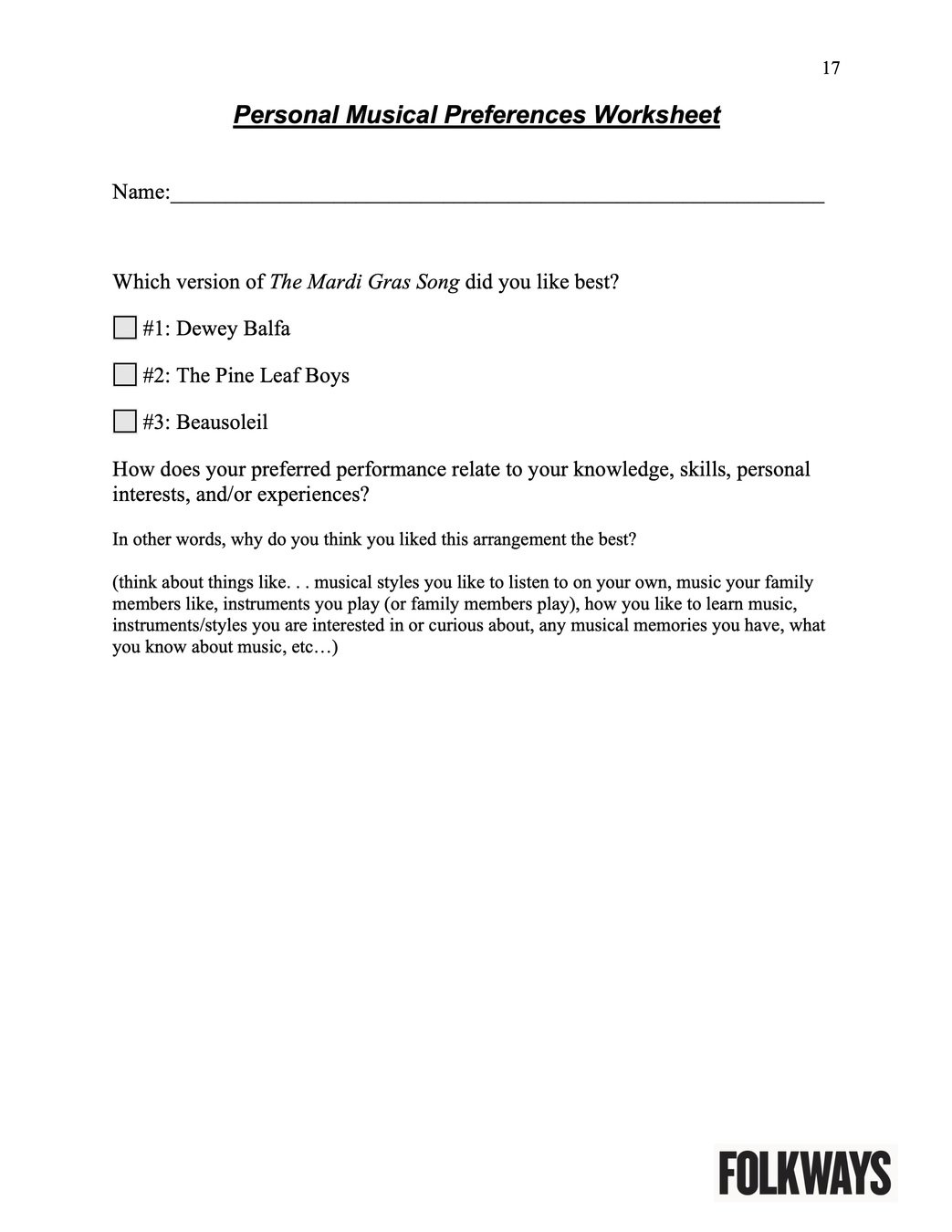Cajun and Zydeco Music: Flavors of Southwest Louisiana

Lesson Hub 10
Cajun and Creole Culture: Food, Dance, and Music

In what ways does music function as an important part of culture in Southwest Louisiana?
Mardi Gras Boys, photo by Gabrielle Savoy.


Cajun and Creole Culture: Food, Dance, and Music
MUSIC MAKING
HISTORY & CULTURE
MUSIC LISTENING
30+ MIN
30+ MIN
30+ MIN

Gumbo, by Mark Miller, CC BY-SA 3.0, via Wikimedia Commons.
Food, Dance, and Music as Culture
Path 1

30+ minutes

Cracklins!, photo by Donna B. Cooper. Flikr.
What Is Culture?

Acadian to Cajun Mural, by Jerome Ford. St. Landry Parish Visitor Center.

Culture Is ...
Although culture is a very difficult concept to define, it is generally understood as an umbrella term that encompasses the social behavior and norms found in human societies, as well as the knowledge, beliefs, arts, laws, customs, capabilities, and habits of the individuals in these groups.


Cajun & Zydeco Word Cloud, by Gisele Hernandez. Smithsonian Folkways Recordings.
Food, Dance, and Music
Three important aspects of Cajun/Creole culture that are frequently intertwined are food, dance, and music.
What do these things have in common?




Food, Dance, and Music ...
. . . bring people together!
The intersection of music, food, and dance is the fabric of Cajun and Creole cultures.

Crawfish Eating Contest, Louisiana Folklife. Louisiana Office of Tourism.

Text
Symbolic Foods in Southwest Louisiana

- Gumbo
- Jambalaya
- Crawfish
- Cracklins
- Boudin


Cracklins (Fried Pork Rind), photo by Jimmy Emerson, CC Y 2.0, Flikr.
Smoked Boudin Blanc, by Nsaum75, CC BY-SA 3.0, via Wikimedia Commons.
Symbolic Foods in Southwest Louisiana



Louisiana Crawfish, photo by Rob Hingle. Public Domain via Wikimedia Commons.
Homemade Jambalaya, photo by Mark Miller. CC BY-SA 3.0, via Wikimedia Commons.
Previously in this pathway (Lesson 1), we used food (gumbo specifically) as a metaphor for music in Southwest Louisiana.
Generally Speaking .....
Food as Culture


Just like a gumbo (which is a unique combination of spices and flavors), the music of Southwest Louisiana is a rich combination of cultural influences and musical flavors.
People gather together to play music while a gumbo cooks; it takes all day.
Generally Speaking .....
Gumbo: More than Just Food!
Creole Mardi Gras, photo by Nicholas R. Spitzer. Louisiana Folklife.


In Southwest Louisiana, cooking a gumbo is about more than just preparing a meal.
Cooking a gumbo is a way feed an entire community . . . it becomes an event!
Generally Speaking .....
Food References in Music

Do you recognize the tune?
Since food is such an important part of culture in Southwest Louisiana, it is often referenced in Cajun and zydeco music.
As you listen to this audio example, think about these questions:
What food references do you hear?
This song references jambalaya, crawfish, and gumbo.
Generally Speaking .....
"Crawfish Jambalaya"
Out West, cover art by Wayne Pope. Arhoolie Records.


This track was recorded in 1973 by zydeco great, Clifton Chenier.
This song is essentially a cover of Hank Williams's hit song “Jambalaya” (originally the melody in the traditional Cajun tune, “Grand Texas”), where Chenier simply plays with the lyrics and themes slightly.
. . . provides another example of how food, music, and dance are deeply intertwined in Southwest Louisiana.
A boucherie is an all-day event that involves killing, butchering, cooking, and eating a pig.
Generally Speaking .....
The Boucherie ....


Cracklins!, photo by Donna B. Cooper. Flikr.
Boucheries: More than Just Food!
The boucherie typically ends with a dance and music.


Lakeview Boucherie, by Herb Roe. CC BY-SA 3.0, via Wikimedia Commons.
The pig is killed in the morning.
The rest of the day is spent cooking.
The people use every part of the pig for something different – boudin sausage, cracklings, hogs head cheese, etc.
Not a piece of the hog goes to waste . . . this is a metaphor for the Cajun way of life.
This is the primary reason why most songs have either a two-step or waltz rhythm.
Generally Speaking .....
Dance as Culture

Where there is food and music (e.g. at a boucherie), there is almost always dance as well.
Cajun and zydeco music is social music: it is meant for people to play and dance together.
Families would move all of the furniture out of a room in their house and have everyone in their neighborhood over to play music and dance.
Generally Speaking .....
Bals de Maison

It all began with Cajun house dances . . . called “bals de maison.”
These were just what the name sounds like . . . dances held in the houses of community members.

Fais Do-Do is a term often used synonymously for a Bals de Maison (house dance) – although sometimes a “Fais Do-Do" would be held at a small public community center.
Generally Speaking .....
Fais Do-Do
Untitled, photo by Russell Lee. Library of Congress.


“Do-Do” is a mutation of the French verb for “sleep” - dormir
Generally Speaking .....
Fais Do-Do


These dances became known as fais do-do's because mothers would bring their children along with them to the dances and put them down to sleep in the next room while they danced and enjoyed the music.
Corner of Dance Hall Reserved for Checking on Children While the Parents Enjoy Fais Do-Do Dance, photo by Russell Lee. Library of Congress.
Literally, the term fais do-do means “go to sleep” in French.
Generally Speaking .....
Fais Do-Do


Fais Do-Do Dance, Cajun Girls Crowley LA, photo by Russell Lee. Library of Congress.
What do these lyrics tell you about the role of dance in Cajun and Creole culture?
Generally Speaking .....
Optional Extension Activity 1: Lyrical Meaning

Listen to this recording of the popular song “J’ai Été au Bal,” (I Was at the Ball) while following along with the lyrics/translation.
Learn how to dance a Cajun waltz!
Generally Speaking .....
Optional Extension Activity 2: Dance the Waltz
Cajun Social Music. Cover design by Nancy Jean Anderson, photograph by Philip Gould. Smithsonian Folkways Recordings.

"Convict Waltz," recorded by Walter Mouton & The Scott Playboys

Learning Checkpoint
- What are three important components of Cajun and Creole culture and why are they important?

End of Path 1: Where will you go next?




Cajun and Creole Mardi Gras
Path 2

30+ minutes

The Cajun Swing, cover design by Ronald Clyne. Folkways Records.

What is Mardi Gras?
Mardi Gras, by Max Spivak. Smithsonian American Art Museum.


Mardi Gras

It is the last hoorah before repenting.


Left: Mardi Gras Headdress. Below: Mardi Gras Beads. Unknown artists. Anacostia Community Museum.
Mardi Gras is based on the ancient tradition of “carnival” - the celebration leading up to the beginning of Lent.
It ends on the Tuesday before Ash Wednesday (“Fat Tuesday” is the literal translation of “Mardi Gras”).
Mardi Gras (or Carnival) Is Celebrated in Many Places Around the World





Marseille Carnival Sun and Moon, by Say-Mars-Say-Yeah, CC BY 3.0, via Wikimedia Commons. (Marseille, France)
Above: Mardi Gras Dakar, by Ji-Elle, Public Domain, via Wikimedia Commons. (Dakar, Senegal) Right: Panorama do sambódromo da Marquês de Sapuca, by Gresasc, CC BY-SA 4.0, via Wikimedia Commons. (Rio, Brazil)
Right: Orange Carnival Masqueraders in Trinidad, by Jean-Marc /Jo BeLo/Jhon-John from Caracas, Venezuela, CC BY 2.0, via Wikimedia Commons. (Trinidad and Tobago)
Mardi Gras in New Orleans


Every year, thousands of people flock to New Orleans during this time to watch the famous parades, attend masquerade balls, dance in the streets, and catch (and wear) green, gold, and purple beads.
Mardi Gras Day 2019 in New Orleans, by Infrogmation of Orleans, CC BY-SA 4.0, via Wikimedia Commons.
The Mardi Gras celebration in New Orleans is among the most famous in the world.
Originally, this hat was meant to poke fun at the traditional hats of the Catholic pope and clergy.


Mardi Gras in Southwest Louisiana
The Mamou Mardi Gras Men's Run 1993, by Maida Owens. Louisiana Folklife.
Mardi Gras is also an important cultural event in Southwest Louisiana . . . but the celebration is quite a bit different than in New Orleans.
People commonly dress up for the event in a specific costume (usually with a pointy hat and a mask).
Courir de Mardi Gras
During these runs they chase chickens to make a gumbo with later.


Courir Run 2010, by Herb Roe, CC BY-SA 3.0, via Wikimedia Commons.
On Mardi Gras Day (Fat Tuesday), many Cajuns participate in an event called the “Courir de Mardi Gras” (“Mardi Gras Run”).
People dress up and go from house to house asking for a small donation from their neighbors.
They then donate this money to charity.
Creole Mardi Gras
In Creole culture, Mardi Gras is celebrated similarly.


Mamou Masked Riders, by John W. Schulze. CC BY 2.0, via Wikimedia Commons.
Optional Video

Clip from Jolie Louisiane, by the Louisiana Educational Television Authority. Louisiana Digital Media Archive.
What is different than other Cajun and zydeco songs you have heard?
Generally Speaking .....
"The Mardi Gras Song"

The traditional “Mardi Gras Song” is sung for the entire season (about two weeks) by Cajuns and Creoles alike.
Listen to a short excerpt from a recording of this song.
“Mardi Gras Song,” recorded by Dewey and Tony Balfa, and Tracy and Peter Schwarz
Generally Speaking .....
Unlike most Cajun and zydeco songs ...

“The Mardi Gras Song” is in a minor key.
Listen again . . .
Discuss:
Does the minor tonality change the “feel” of a song? In what ways?
The use of a minor tonality helps to convey the message of this song . . . According to Dewey Balfa, participants are actually “praying or begging through the melody.”
Generally Speaking .....
More about "The Mardi Gras Song"

Dewey Balfa, unknown artist. Smithsonian Folkways Recordings.

According to Cajun great Dewey Balfa, this song is about “begging”:
Although the exact lyrics vary from town to town, they generally tell the story of the “Courir de Mardi Gras” (asking for money for charity and food for the gumbo, chasing the chicken, etc.).
As you listen, make note of the ways in which music elements and expressive qualities are used (e.g., what instruments do you hear? Style . . . is this Cajun or zydeco? How about the tempo? Time/rhythm? Melody?).
Generally Speaking .....
Compare and Contrast: "The Mardi Gras Song"

SAMPLE 1: Dewey Balfa
SAMPLE 2: The Pine Leaf Boys
SAMPLE 3: Beausoleil
Next, you will listen to and analyze three different versions of “The Mardi Gras Song.”
Some factors that influence our personal preferences for music include:
- Previous musical experiences, music we hear (or have heard) at home or in our community, musical memories, instruments we play, previous musical training, etc.
Generally Speaking .....
Personal Musical Preferences

As you completed the previous exercise, you might have noticed that you liked one arrangement of this song better than the others.
Perhaps your favorite arrangement differs from those of people sitting around you.
Complete the “Personal Preferences Worksheet.”
- Think about the ways in which the arrangement you liked best relates to your knowledge, skills, personal interests, and/or experiences
Generally Speaking .....
Exploring Personal Musical Preferences

Learning Checkpoint
-
What factors can affect our personal preferences for music?

-
In what contexts is “The Mardi Gras Song” sung in Southwest Louisiana?
End of Path 2: Where will you go next?




Learning "The Mardi Gras Song"
Path 3

30+ minutes


Basile Mardi Gras, by Maida Owens. Louisiana Folklife.
Integrating: Understanding "The Mardi Gras Song"
“The Mardi Gras Song” is commonly sung at events during the entire Mardi Gras season in Southwest Louisiana.
Listen, while following along with the lyrics/translation.
Next, discuss the meaning of this song.


"The Mardi Gras Song," recorded by the Savoy-Doucet Cajun Band
Integrating: Lyrical Meaning
Although the lyrics can vary from one interpretation to the next, they usually tell the story of the “Courir de Mardi Gras”:
- Catching the chicken, asking for donations of money and food, eating gumbo together, celebrating, etc.



Courir de Mardi Gras, by Herb Roe. CC BY-SA 3.0, via Wikimedia Commons.
Attentive/Engaged Listening: Time
What is the time structure?
Can you tap/clap along?


Attentive/Engaged Listening: Rhythm


Do you hear any repeated rhythmic patterns?
Can you tap/clap them?
Enactive Listening: Practice Your French!
Can you use the pronunciation guide to practice speaking the French lyrics?


Engaged and Enactive Listening: Melody


Can you sing along with the recording (using the French lyrics)?
Can you hum along with the melody?
Can you try it without the recording?
Enactive Listening and Creating World Music:
Put It All Together!
Students might also:
Play or sing the melody, keep steady time on a percussion instrument, or create and play a rhythmic ostinato.


Consider making a video or audio recording of your performance or performing it for a live audience (perhaps even during the Mardi Gras season).
Create (and perform) your own class arrangement of “The Mardi Gras Song.”
This song has three chords (A minor, E minor, and G Major) and is perfect for students for students who are learning to play the guitar or ukulele.
Learning Checkpoint


- What is “The Mardi Gras Song” about?
- In what way is this song different than other Cajun songs you have heard?
End of Path 3 and Lesson Hub 10: Where will you go next?



Lesson Hub 10 Media Credits

Audio courtesy of
Smithsonian Folkways Recordings
Video courtesy of
Louisiana Digital Media Archive
Images courtesy of
Anacostia Community Museum
The Arhoolie Foundation
Donna B. Cooper
Library of Congress
Louisiana Folklife
Smithsonian American Art Museum
Smithsonian Folkways Recordings
Gabrielle Savoy
St. Landry Parish Tourist Commission

© 2022 Smithsonian Institution. Personal, educational, and non-commercial uses allowed; commercial rights reserved. See Smithsonian terms of use for more information.
This Lesson was funded in part by the Grammy Museum Grant and the Smithsonian Youth Access Grants Program, with support from the Society for Ethnomusicology and the National Association for Music Education.
For full bibliography and media credits, see Lesson 10 landing page.



